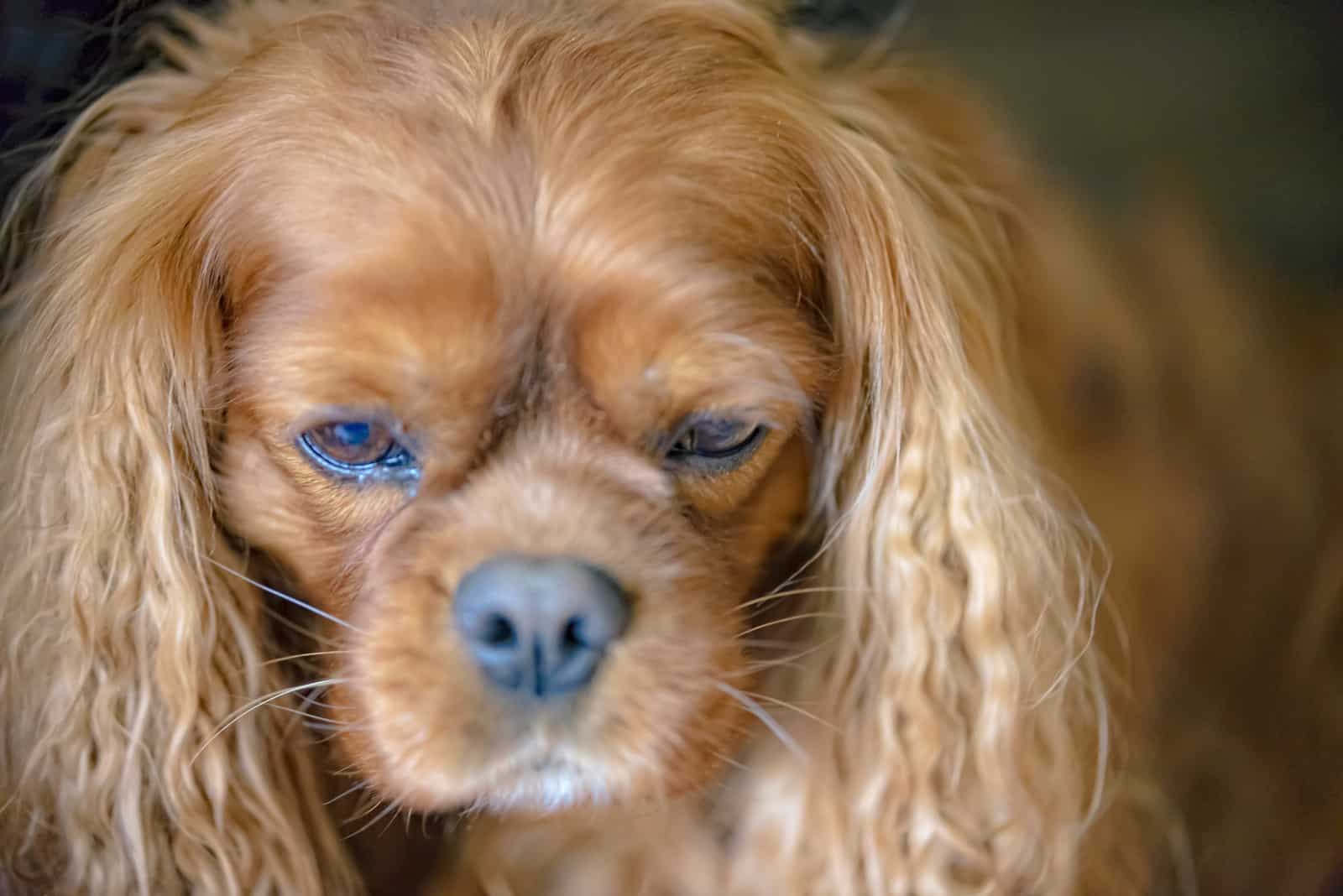Nothing makes dog owners sadder than the realization that our pooches live significantly shorter lives than we do. We would do anything just to have our canine companions with us for a bit longer.
When choosing the right breed for themselves, most people take a dog’s life expectancy into consideration. So, what about the Cavalier King Charles Spaniel lifespan? Is this a healthy, long-living breed?
If you’ve watched Disney’s Lady and the Tramp, you are familiar with this long-haired dog breed. The Cavalier King Charles Spaniel became the image of a spoiled dog owned by the higher class.
But, how long will these doggies stay with us?
A Cavalier King Charles Spaniel has an average lifespan of 9 to 14 years. This means they will stay by our side for over a decade!
However, just as with any other dog breed, many things can affect the life expectancy of our pups. Because of this, predicting the longevity of a canine can be an unrewarding task.
Still, to answer this question as precisely as possible, we have conducted thorough research, and this is what we have found about the lifespan of the Cavalier King Charles Spaniel.
How Long Does The Cavalier King Charles Spaniel Live?

As we’ve mentioned, the average lifespan of a Cavalier King Charles Spaniel is 9 to 14 years. However, it’s important to note that these dogs are susceptible to approximately 25 genetic disorders!
The most common of these disorders is mitral valve disease (MVD), a condition that most CKCSs will get at a certain point in their lives. This condition can severely shorten your pup’s lifespan, which is one of the main reasons why these dogs might live shorter than predicted.
Other diseases that we’ll explain in detail later on include hip dysplasia, syringomyelia, retinal dysplasia, and so on. While none of these diseases are as common as MVD, the number of cases seems to be increasing as time goes on, so this is something you need to be aware of.
When all this is taken into account, the average lifespan of this lap dog breed is 9.9 years.
Healthy Cavalier King Charles Spaniels can live a fairly long life. However, those who are affected with MVD at a young age can die reasonably young.
The reason behind this huge number of genetic disorders lies in the dog’s origin.
While this is a relatively new dog breed, it originated from a toy breed that many royal families owned in the 17th and 18th centuries. They got their name from King Charles II, who was a huge fan of the breed.
After the death of King Charles II, the breed’s popularity waned, and these dogs were mixed with bulldogs and pugs, breeds that became new royalty favorites.
Things changed in 1920 when Roswell Eldridge brought these purebred small animals from England to the USA, where this breed was known under the name “English Toy Spaniel.”
At first, the American Kennel Club (AKC) wouldn’t recognize this breed, so the Cavalier King Charles Spaniel Club was founded. Then, in 1955, Lady and the Tramp premiered, and the rest is history.
Today, these intelligent therapy dogs (although some owners use them as guard dogs, as well!) are loved by many. One of the reasons behind this is their floppy ears with feathering and gorgeous puppy dog eyes.
The other is the huge number of colors they come in. You can find them in dark golden, black and tan, Blenheim (white and ruby), even tricolor! No matter the combination, these pups are adorable.
Since this Spaniel dog breed was fairly new in the USA, most breeders resorted to inbreeding. With such a limited gene pool, these dogs became sickly and prone to harmful genetic conditions.
In fact, surveys show that purebred CKCSs born in the USA have a somewhat shorter lifespan than those bred in Europe. This is because there were more dogs of this breed to reproduce in the Old Continent compared to the number of dogs Roswell Eldridge and others imported.
Health Problems That Affect A Cavalier King Charles’ Lifespan

To understand Cavalier King Charles Spaniel’s life expectancy, you need to know about the most dangerous health issues this breed can have.
While it would be very challenging to go over every single genetic condition that can affect these small dogs, we’ll explain the most common and deadliest ones. All of these disorders can ruin your Spaniel’s quality of life, cause severe pain, and overall prevent your dog from dying of old age.
Mitral Valve Disease (MVD)
Mitral valve disease is a terminal and painful heart disease that affects these pups. At the same time, it’s excruciating for the Cavalier King Charles Spaniel’s owners, as they have to go through this with their beloved pooch.
This heart disorder typically ends with a premature and agonizing death for the CKCS, and the owners face months, if not years, of heartbreak.
MVD causes the mitral valve between the upper and the lower left heart chamber to stop working properly. This might cause blood to regurgitate, leak backward to the atrium, or cause a narrowed valve – a condition called stenosis.
Either way, the condition inevitably leads to heart failure.
Average Lifespan Of A Cavalier King Charles Spaniel With A Heart Murmur
There is no cure for this disease. Very young dogs might even develop these mitral murmurs, but it usually occurs when they are around four years old. The average lifespan of Cavalier King Charles Spaniels with a heart murmur is no longer than three years, although many don’t live that long.
MVD is very present in this dog breed. In fact, Cavalier King Charles Spaniels are more than 20 times more likely to develop this disease than any other breed. It is so prevalent that around half the Cavaliers will develop this disease around the time they are five years old!
By the age of ten, almost all CKCSs will have developed this deadly sickness.
The Mitral Valve Disease Protocol
In the 1990s, a group of veterinary geneticists and cardiologists gathered together to examine the high incidence of MVD in Cavalier King Charles Spaniels. They created a set of rules for breeders, called the MVD Breeding Protocol that they released in 1997 and 1998.
The MVD Breeding Protocol was given to Cavalier Breeders at an event sponsored by the Cavalier King Charles Spaniel Club, and all breeders were advised to strictly follow the rules it imposed.
According to the protocol, breeders should only breed dogs older than five that don’t have an indication of MVD. A board of certified veterinary cardiologists would examine the dogs and make sure their hearts were clear of MVD murmurs.
The only exception to this protocol was if both of the Cavalier’s parents’ hearts were clear of murmurs when these dogs reached five years old. If this was the case, the breeder could reproduce the offspring of such healthy parents when the dogs reached 2.5 years of age.
This protocol was accepted in 1998, and it was expected to drastically reduce the early-onset of MVD in Cavaliers. Some experts believed this might even eliminate the disease from this age group.
The problem was that the protocol required breeders to drastically alter their breeding practices, which also reduced the number of dogs they could breed. Up until then, most breeders bred their dogs as soon as they were one year old.
Unfortunately, but as was expected, the majority of Cavalier King Charles Spaniels’ breeders in the USA ignored the protocol.
In fact, they doubled the breeding of very young Cavaliers, as the demand for these dogs had been on the rise since 1995 when the AKC finally recognized this breed. This event only caused inexperienced breeders to start mating these pups, unaware of their numerous health problems.
With the increase of puppy mills and pet shops that sell dogs without ever conducting any health tests, MVD only became more prevalent.
While veterinarians and cardiologists expected early-onset MVD to be eradicated in just a few generations, quite the opposite happened. The protocol didn’t encourage any progress in this field.
In fact, on the panel in November 2009, it was reported that every single Cavalier King Charles Spaniel would almost certainly develop mitral valve disease at a certain point in their lifetime.
Because of this, vets recommend all Cavalier King Charles Spaniels be screened for heart murmurs at least once every year.
Syringomyelia (SM)

While not as common as MVD, syringomyelia presents yet another problem that affects the Cavalier King Charles Spaniel’s lifespan. This is a crippling and severe genetic spinal disease that affects Cavaliers of all bloodlines.
Fairly rare before the late 1990s, recently, this disease seems to have spread dramatically.
SM starts with a Cavalier King Charles Spaniel feeling hypersensitivity in its neck area. You can notice this if it excessively scratches this body part.
As time passes, SM will cause severe pain in the dog’s neck, head, and shoulders. The dog is likely to yelp or scream, as this is the only way it can express the pain it feels.
Slowly but surely, the disease will destroy portions of a CKCS’s spinal cord.
This is one of the most devastating conditions for both the dogs and their owners.
The affected dog will be in so much pain that it might contort its neck or even eat and sleep only with its head held high, as this is the most comfortable position for them.
Many CKCSs will lose full use of their limbs, as well as control over their bladder and bowel movements. In some dogs, the disease will progress so much that it can cause full paralysis.
Today, SM is so widespread in this dog breed that there is no way of creating a breeding program that will fully avoid its genetic carriers.
In fact, it is estimated that up to 95% of Cavalier King Charles Spaniels carry the genes for SM, which can be noticed in a Chiari-like malformation (CM). CM is a skull malformation that is believed to be one of the causes of syringomyelia.
Approximately 50% of Cavalier King Charles Spaniels have this terrifying disorder.
Similar to the MVD protocol, there was an attempt to create an SM protocol that included eliminating all SM-affected dogs from breeding programs. The medical examinations to determine whether a dog has genes for SM include magnetic resonance imaging (MRI).
Unfortunately, just like with other guidelines, only a few breeders abide by the SM protocol, so this condition is only spreading further.
Hip Dysplasia

This is another heritable bone disease the Cavalier King Charles is prone to.
Hip dysplasia is abnormal hip development, which is debilitating and painful. It can lead to several varying degrees of arthritis – which can also be called arthrosis, degenerative joint disease, or osteoarthrosis.
Most experts believe that around 25% of Cavalier King Charles Spaniels suffer from this disease, but the estimations vary.
In some dogs, hip dysplasia is caused by genetics. However, it is proven that many environmental factors can also lead to it, especially if the dog has lived an unhealthy life since puppyhood.
Some of the factors that can lead to hip dysplasia include obesity, certain types of exercises, and floor surfaces.
One of the ways you can lower the chances of your pup developing hip dysplasia is by ensuring your CKCS has enough exercise and eats healthy foods. Obese dogs are much more likely to get this uncomfortable condition.
CKCS’ have a sensitive stomach. You probably already know that you shouldn’t give him spicy foods, spam, or Doritos. However, you should also avoid foods that are high in sugar and fats, such as:
• sausages
A dog with hip dysplasia might hop like a bunny or swivel with its hips while running. It might also experience issues climbing up or down the stairs.
Your dog might show signs of hip dysplasia at various stages of the disease. Some dogs with severe dysplasia will still run, jump, and enjoy playtime as if nothing’s wrong. On the other hand, some dogs with a very mild case might be very lame.
While hip dysplasia won’t affect the Cavalier King Charles Spaniel’s lifespan, it will ruin its quality of life.
Patellar Luxation

Patellar luxation is a recurring hereditary condition that you might know as ‘loose knee caps.’ It is believed that around 20% of Cavalier King Charles Spaniels suffer from this disorder.
Patellar luxation affects a dog’s patella, or rather its knee cap.
Normally, the patella is located in its groove in the middle of the knee joint of the femur. However, when you have a luxating patella, this means that the knee cap is moving out of its groove.
Some of the genetic conditions that cause patellar luxation are weak ligaments, a shallow groove, as well as the misalignment of the ligaments and muscles between the patella, femur, and tibia, or lower leg bone.
Sometimes, this condition doesn’t have any symptoms. If this is the case, your dog doesn’t have any physical problems. These occult conditions usually don’t require any medical care, and you should only monitor your dog to ensure nothing worsens.
On the other hand, when the symptoms are apparent, we’re talking about clinical cases. On these occasions, the condition has to be fixed. If you don’t take your dog to the vet in time, the patella ridges might wear, its groove might become more shallow, and your dog will lose mobility.
Similar to hip dysplasia, patellar luxation won’t directly affect Cavalier King Charles Spaniels’ lifespan, but it can make his life painful, which may result in having to put your dog to sleep.
Eye-Related Disorders And Ear Infections

Eye-related disorders make up a considerable portion of the genetic disorders these pups suffer from. Around 30% of these dogs experience some kind of eye issue.
These include:
• Hereditary cataracts
• Corneal ulcers
• Corneal dystrophy
• Distichiasis
• Dry eye syndrome
• Progressive retinal atrophy (PRA)
• Cherry eye
• Entropion
• Microphthalmia
• Retinal dysplasia
Cataracts are the unusual opacity of the lens, which is usually white in color, but it can have a grayish or yellowish appearance. This opacity scatters the light rays, impairing the vision.
In CKCSs, the most common is the early-onset juvenile cataract, which can lead to complete blindness before the dog reaches four years of age.
Corneal ulcers are common in Cavalier King Charles Spaniels due to their short muzzles and unusual head shapes that make their eyes bulge. They can also result from dry eye syndrome or other dry eye conditions that weren’t treated in time.
Corneal dystrophy is a common genetic disorder that is caused by gray-white opaque calcium and fat build-up under both corneas’ surfaces. This condition is common in younger Cavalier King Charles Spaniels. The usual form of corneal dystrophy in CKCSs is epithelial or stromal dystrophy.
One study concluded that corneal dystrophy in Cavalier King Charles Spaniels could be an ocular manifestation of Cushing’s disease.

Photo from @indiacavalierslife
Distichiasis is the abnormal growth of eyelashes in areas where they shouldn’t be. It can result in a second row of eyelashes in dogs, causing eye irritations or even blindness.
Progressive retinal atrophy is a disease that causes the degeneration of a dog’s eyesight. It prevents the pup’s pupils from responding appropriately to light.
This disease usually starts as the loss of night vision, but it quickly progresses into full blindness.
Some Cavalier King Charles Spaniels are prone to cherry eye, or rather the prolapsed gland of nictitans. Fortunately for dog owners, most purebred CKCSs won’t develop this disease, as its appearance in their bloodlines is the result of mixing Cavalier King Charles Spaniels with other dog breeds, such as with Bulldogs, Beagles and Cocker Spaniels.
Entropion is an inward rolling of the edges of the eyelids. This causes eyelashes to rub against the cornea. It usually affects the lower eyelid, but it can affect both. This condition can cause severe injuries to the eye and blindness.
This disease is common in Cavalier King Charles Spaniels, and it’s usually noticeable just a few months after birth.
Microphthalmia is a hereditary defect that leads to one or even both eyes being smaller than normal.
Retinal Dysplasia is another fairly common eye problem with Cavalier King Charles Spaniels, and about 28% of this dog breed suffers from it.
This disease, in fact, is the malformation of the retina, causing blind spots. It can be mild or ‘geographic,’ while the severe cases are called ‘retinal detachment.’ Dogs with retinal detachment are entirely blind.
Due to their large ears, Cavalier King Charles Spaniels are also prone to ear infections. Although painful and uncomfortable, they will rarely lead to deafness.
Some of the common causes of ear infections are:
• Overgrowth of hair in the ear canals
• Accumulation of earwax
• Swimming
• Allergies
While none of these diseases affects a dog’s lifespan, some conditions can be quite painful if left untreated.
Epilepsy

Idiopathic epilepsy is the most prevalent chronic neurological disorder in dogs, and Cavalier King Charles Spaniels are especially prone to it.
This condition causes repeated seizures that can vary in intensity from mild to severe.
Epilepsy shouldn’t be confused with fly catcher’s syndrome and seizures caused by skull malformations, such as the Chiari-like malformation.
Funnily enough, there is a connection between the coat color of Cavalier King Charles Spaniels and the chances of a dog having epilepsy.
Epilepsy is more likely to occur in dogs that had ancestors of one color. This is because most of these dogs are the result of inbreeding, which leads to many genetic disorders – one of them being idiopathic epilepsy.
Fortunately, epilepsy isn’t deadly, and many medications can be used to keep it at bay. Today, this disorder usually doesn’t affect the dog’s quality of life or a Cavalier King Charles Spaniel’s lifespan – as long as it is treated.
Diabetes Mellitus

The Cavalier King Charles Spaniel breed is very susceptible to developing diabetes mellitus, an incurable genetic disease that prevents a canine organism from converting glucose into energy.
This results in extremely high blood sugar levels, leading to the presence of glucose in the urine.
Diabetes mellitus is caused by an insulin deficiency, a hormone required to utilize ingested proteins, carbohydrates, and fats.
Most dogs won’t develop diabetes until they are around six years old. However, in Cavalier King Charles Spaniels, this disease can appear while these doggies are just a few months old.
The symptoms of diabetes mellitus vary greatly. At first, a dog might just experience excessive thirst, weight loss, and poor appetite. His breath might smell sweet, which is one of the most noticeable signs.
Diabetes can’t be cured, but it can be treated with medications that keep it under control. A medicated dog’s lifespan usually won’t be affected.
However, if left untreated, diabetes can cause more severe conditions such as ketoacidosis, which can result in a sudden appearance of cataracts, blindness, lethargy, coma, and, finally, death.
Why Is This Happening?

As you can see, many genetic disorders can shorten a Cavalier King Charles Spaniel’s lifespan. In fact, it seems like these dogs are more likely than not to develop some form of a deadly condition. But why is that?
Several initiatives were trying to make a Cavalier King Charles Spaniel a healthy breed. This included careful breeding and genetic testing of possible parent dogs.
However, MVD and SM protocols failed, and these once royal dogs’ health seems to only be deteriorating.
Most breeders choose to breed their Cavaliers while they are young, breed them often, and either refuse to test them for genetic diseases or simply ignore the test results and breed the dogs knowing that they aren’t healthy.
While it seems like there is no stopping the breeders’ greed, dog lovers looking to buy Cavalier King Charles Spaniel puppies need to be aware of the irresponsible behavior of many breeders.
This isn’t to say that responsible Cavalier King Charles Spaniel breeders don’t exist – they most certainly do. However, statistics show that even some of the more reputable breeders don’t follow the breeding programs.
If you plan on getting a Cavalier puppy – go ahead! These adorable pups make great family pets. Just make sure you are getting him from a reputable breeder, and ensure your dog gets annual testing by your veterinarian.
Read Next:
• Dog Years To Human Years: What Is My Dog’s Age?
• Is The Short-Hair Cavalier King Charles Spaniel A Myth?
• Is Cavalier King Charles Spaniel Shedding That Bad?


